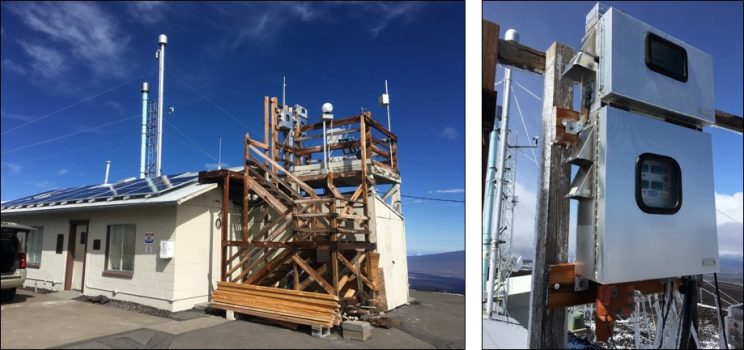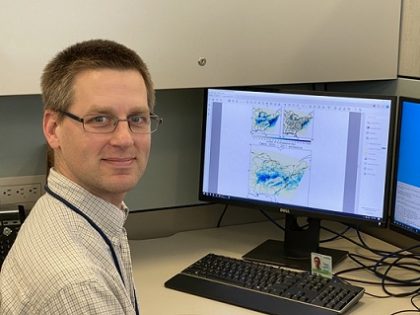From February 9-19, Paul Kelley and Winston Luke traveled to the Big Island of Hawaii to visit the Mauna Loa Observatory (MLO). While there, the two performed semi-annual maintenance, repairs, and calibrations of the trace gas and aerosol monitors; trained a new site operator to operate the instrumentation; and collaborated with Dr. Akane Yamakawa from the National Institute for Environmental Studies in Tsukuba, Japan, to deploy and test a prototype sampler for the collection of gaseous oxidized mercury compounds for subsequent isotopic analysis.

ARL’s instruments reside on the exterior platform of the historic Keeling Building at the Mauna Loa Observatory. A close-up of the atmospheric mercury measurement equipment shows the particulate-bound mercury and gaseous oxidized mercury monitors (top and bottom boxes, respectively). Credit: NOAA
Christopher Loughner was interviewed about his research showing the effectiveness of air quality emissions controls as highlighted in his recent publication “The benefits of lower ozone due to air pollution emissions reductions (2002-2011) in the Eastern US during extreme heat.” The interview was posted on the NOAA Research website on February 20 and featured on the @NOAAReseach Twitter and Facebook pages.
Alice Crawford and Tianfeng Chai will each present a poster during the JPSS/GOES-R Proving Ground / Risk Reduction Summit at the NOAA Center for Weather and Climate Prediction in College Park, Maryland. Dr. Chai will present “Wildfire smoke forecasts using HYSPLIT-based emission inverse modeling system and GOES observations,” co-authored by Hyun Cheol Kim, Ariel Stein, and Shobha Kondragunta, on February 25 and on February 26 Dr. Crawford will present “ Volcanic Ash Forecasting for Aviation.”
On February 26 Christopher Loughner will present “STILT features incorporated into the HYSPLIT model” at the Meteorology for Nuclear Emergencies and Nonproliferation meeting. This event is taking place at Lawrence Livermore National Laboratory’s National Atmospheric Release Advisory Center in Livermore, California.


